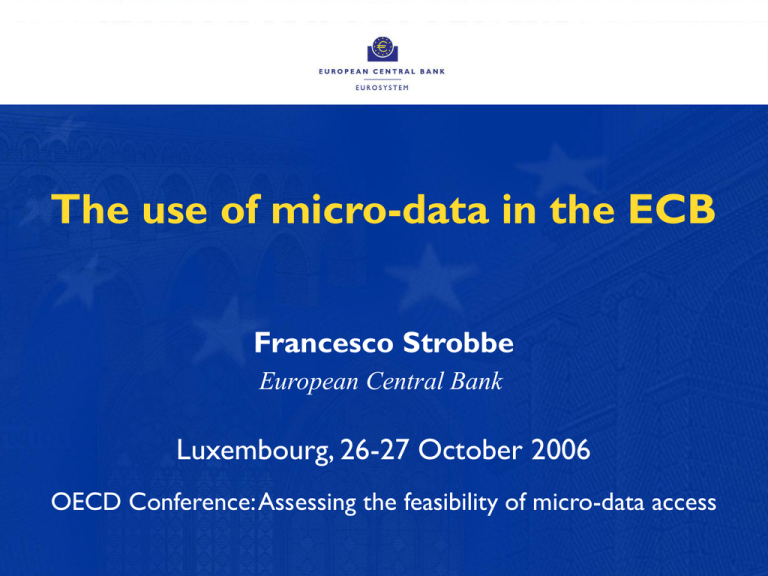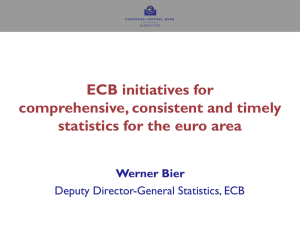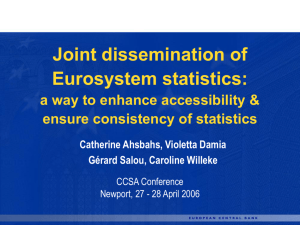The use of micro-data in the ECB Francesco Strobbe
advertisement

The use of micro-data in the ECB Francesco Strobbe European Central Bank Luxembourg, 26-27 October 2006 OECD Conference: Assessing the feasibility of micro-data access The use of micro-data in the ECB - I Monetary policy analysis is mainly based on macro statistics (mainly collected from EU NCBs) but more and more interest also in micro data based analysis Moreover micro-data bases have high potential to make statistical production more efficient The use of micro-data in the ECB - II In particular, the ECB is currently working on 4 main projects in the field of financial micro-data: – Centralised Securities Database (CSDB) – Market Data Provision Project (MDP) – Survey data on Households Finance and Consumption (HFC) – Euro Area Corporate Balance Sheet Data (EACBS) Centralised Securities Database (CSDB) - I • The CSDB is a comprehensive database developed by the ECB • It contains information on over 2 millions debt securities, equities and mutual funds issued by EU residents or by others • It uses commercial and other statistics sources, selecting the most reliable value for each attribute • It makes use of expertise within the ESCB to enhance data quality and filling gaps (on prices and income) with reliable estimates Centralised Securities Database (CSDB) - II • The CSDB has been launched in first place to support ESCB wide production systems in the area of financial statistics • To this end the aim of the CSDB is to hold complete, accurate, consistent and up-to-date information on all individual securities relevant for the statistical purposes of the ESCB • From a statistical angle, the CSDB has 2 main functions: – To compile euro area aggregates – To provide a reference source on individual securities and issuers Centralised Securities Database (CSDB) - III • Statistics on financial stocks and flows broken down by institutional sector and broad class of financial instrument are essential for the conduct of monetary policy • Microeconomic analysis of financial markets, focusing on specific instruments and markets, is growing in importance (e.g. : risks of different types of instruments and exposure of debtors and creditors in Basel II) • Reliable information on individual securities is also relevant for the ECB’s operational purposes (e.g. assets eligible as collateral in Eurosystem monetary operations). Centralised Securities Database (CSDB) - IV Centralised Securities Database (CSDB) - V • The Production system of the CSDB is currently updated on a daily basis; the data dissemination system is refreshed monthly • Online access to the CSDB is available only in the ECB • Future developments: – Phase 2: online access to data for central banks and automated data exchange – Possibly Phase 3: inclusion of information on holders of securities (providing aggregates by country of residence and, where possible, by economic sector) Market Data Provision (MDP) - I • The ECB uses financial market statistics in order to analyse the relationship between monetary policy and the structure and dynamics of financial markets; • The analysis of high-frequency series offers an insight into instantaneous reactions of market participants to specific events; • Primary objective of the MDP project is to deliver a system able to: – Collect, store and filter prices, volumes and a minimal set of reference data of financial market instruments at instrument level and at various frequencies from a few major data providers Market Data Provision (MDP) - II • The financial markets data collected, from various geographical regions and in various currency denominations, includes: – Interest rate related instruments (deposits, loans, derivatives etc) – Equity related instruments (stocks, indices, derivatives etc) – Foreign exchange (currencies, derivatives etc) – Commodity derivatives, credit derivatives and other financial market instruments • The data is used for the production of statistics for internal and external use. These statistics include: – Financial market indicators, such as the yield curves, volatilities and indices, etc. – Financial integration indicators, such as the money market, bond market and corporate bond market indicators, etc. Households Finance and Consumption (HFC) - I • So far the ECB used households’ data based on the European Community Household Panel (ECHP) to: – Assess the financial vulnerability of mortgage-indebted euro area households (Financial Stability Review, Dec. 2005) – Assess the debt servicing burden of euro area households – microeconomic evidence (ECB Monthly Bulletin, Dec. 2005) – Estimate the labour quality in the euro area (ECB Monthly Bulletin, Oct. 2005 and ECB Working Paper No. 575) • While ECHP data proved to be good when focusing on income or labour issues, the same does not apply to finance/portfolio issues Households Finance and Consumption (HFC) - II • Comparable and comprehensive micro data on HFC covering the entire euro area are not available • The Eurosystem is currently investigating the need and the feasibility of collecting survey data on households finance and consumption • A coordinated survey for the euro area on HFC would: – Support policy analysis in all major functions of the Eurosystem (monetary policy; financial stability; payment systems) – Offer a consistent cross-country picture of households assets and liabilities – Enhance the understanding of the mutual interaction between households behaviour, financial markets and the macro-economy Households Finance and Consumption (HFC) - III • Survey data can help address many questions of vital interest to central banks at various stages of the policy making process: – Households finance and consumption patterns – Measurement of households net worth – Borrowing and liquidity constraints – Marginal propensity to consume out of wealth • Some examples for the possible use of survey data: – Real estate booms and financial vulnerability of households sector – Financial integration and modernisation in retail banking – Aging, pension reforms and saving patterns Households Finance and Consumption (HFC) - IV • The data would complement other micro-economic data (e.g. firms’ and banks’ balance sheets; bank lending survey) and macro-economic data on the households sector (e.g. financial and non-financial accounts) • Special challenges posed by the data collection: – Households may be reluctant to reveal info on financial matters in particular wealthy ones, these should therefore be over-represented in the sample – Representative samples for each country for meaningful comparisons Corporate Balance Sheet Data (CBS) - I • CBS are an important statistical source to analyse the economic behaviour of non-financial corporations in the euro area; • Changes in monetary policy influence the financing conditions of enterprises via various channels (i.e. interest rate, credit and balance sheet channels) • A detailed understanding of – corporate financing decisions – the financial situation of corporations – the cost of financing is important for monetary policy in the context of an assessment of financial and economic developments. Corporate Balance Sheet Data (CBS) - II • CBS may be derived by aggregating national balance sheets and income statements made available by: – National authorities (generally Central banks or Statistical Offices) – Commercial Data Providers • So far, the compilation of EACBS has been complicated by: – Lack of comprehensive and timely data – Heterogeneity of accounting standards in Member States – Confidentiality constraints (exchange of individual data) Corporate Balance Sheet Data (CBS) – III Purpose Monetary policy analysis Dimension Conjunctural analysis Structural analysis Financial stability analysis Other statistical purposes Timeliness Very important Less important Important Very important Frequency Quarterly Annual Quarterly and annual Quarterly and annual Coverage by economic activity, size, and legal form Important Important Important Less Important Country coverage Important Important Important Important Back data Very important Important Less important Very important Compatibility with national and financial accounts Very important Important Less important Very important Individual data Less important Important Important Less important Consolidation Consolidated and nonconsolidated Nonconsolidated Consolidated and non- Non-consolidated Corporate Balance Sheet Data (CBS) – IV Aggregated non-financial corporation data National CBSOs data (only available on request) BACH database CBS Data available at the ECB Amadeus database Individual nonfinancial corporation data OSIRIS database Thomson Financial database Corporate Balance Sheet Data (CBS) - V • Annual and quarterly analysis of the financial conditions of the euro area non-financial corporations sector (broken down by branch of activity and size class) – Thomson Financial; Amadeus; BACH • Quarterly analysis (in the ECB Monthly Bulletin) – Quarterly euro area sample drawn from Thomson Financial • Financial Stability Review (Balance sheet conditions of nonfinancial corporations) – Amadeus and Thomson Financial Corporate Balance Sheet Data (CBS) - VI • Collection of balance sheet data: costly undertaking • Therefore the ECB, in cooperation with the European Committee of CBS Data Offices, strives for further improvements regarding: – Timeliness – Frequency – Availability of individual data Concluding remarks • The use of financial micro-data will increasingly support policy analysis in all major functions of the Eurosystem • Still a lot work has to be done but the ECB supports initiatives, like the OECD conference, aiming at exchanging best practices at international level and at fostering a dialogue on this topic


